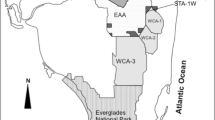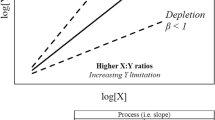Abstract
Natural, unenriched Evergladeswetlands are known to be limited by phosphorus(P) and responsive to P enrichment. However,whole-ecosystem evaluations of experimental Padditions are rare in Everglades or otherwetlands. We tested the response of theEverglades wetland ecosystem to continuous,low-level additions of P (0, 5, 15, and30 μg L−1 above ambient) in replicate,100 m flow-through flumes located in unenrichedEverglades National Park. After the first sixmonths of dosing, the concentration andstanding stock of phosphorus increased in thesurface water, periphyton, and flocculentdetrital layer, but not in the soil or macrophytes. Of the ecosystem components measured, total P concentration increased the most in the floating periphyton mat (30 μg L−1: mean = 1916 μg P g−1, control: mean =149 μg P g−1), while the flocculentdetrital layer stored most of the accumulated P(30 μg L−1: mean = 1.732 g P m−2,control: mean = 0.769 g P m−2). Significant short-term responsesof P concentration and standing stock wereobserved primarily in the high dose (30 μgL−1 above ambient) treatment. Inaddition, the biomass and estimated P standingstock of aquatic consumers increased in the 30and 5 μg L−1 treatments. Alterationsin P concentration and standing stock occurredonly at the upstream ends of the flumes nearestto the point source of added nutrient. Thetotal amount of P stored by the ecosystemwithin the flume increased with P dosing,although the ecosystem in the flumes retainedonly a small proportion of the P added over thefirst six months. These results indicate thatoligotrophic Everglades wetlands respondrapidly to short-term, low-level P enrichment,and the initial response is most noticeable inthe periphyton and flocculent detrital layer.
Similar content being viewed by others
References
Amador JA & Jones RD (1993) Nutrient limitations on microbial respiration in peat soils with different total phosphorus content. Soil Biology and Biochemistry 25: 793-801
Bachoon D & Jones RD (1992) Potential rates of methanogenesis in sawgrass marshes with peat and marl soils in the Everglades. Soil Biology and Biochemistry 24: 21-27
Bedford BL, Walbridge MR & Aldous A (1999) Patterns in nutrient availability and plant diversity of temperate North American wetlands. Ecology 80: 2151-2169
Browder JA, Gleason PJ & Swift DR (1994) Periphyton in the Everglades: Spatial variation, environmental correlates, and ecological implications. In: Davis SM & Ogden JC (Eds) Everglades: The Ecosystem and its Restoration (pp 379-418). St. Lucie Press, Delray Beach
Carpenter SR, Caraco NF, Correll DL, Howarth RW, Sharpley AN & Smith VH (1998) Nonpoint pollution of surface waters with phosphorus and nitrogen. Ecological Applications 8: 559-568
Chapin FSIII, Barsdate RJ & Barèl D (1978) Phosphorus cycling in Alaskan coastal tundra: A hypothesis for the regulation of nutrient cycling. Oikos 31: 189-199
Childers DL, Jones RD, Trexler J, Buzzelli C, Dailey S, Edwards AL, Gaiser E, Jayachandaran K, Lee D, Meeder J, Nair M, Pechmann J, Renshaw A, Richards J, Rugge M, Scinto L, Sterling P & Van Gelder W (2002) Quantifying the effects of low-level phosphorus enrichment on unimpacted Everglades wetlands with in situ flumes and phosphorus dosing. In: Porter K & Porter J (Eds) The Everglades Hydroscape (pp 127-152). St. Lucie Press, Delray Beach
Craft CB & Richardson CJ (1993) Peat accretion and N, P, and organic C accumulation in nutrient-enriched and unenriched Everglades peatlands. Ecological Applications 3: 446-458
Craft CB, Vymazal J & Richardson CJ (1995) Response of Everglades plant communities to nitrogen and phosphorous additions. Wetlands 15: 258-271
Daoust RJ (1998) Investigating how Phosphorus Controls Structure and Function in Two Everglades Wetland Plant Communities. M.S. Thesis. Florida International University, Miami
Daoust RJ & Childers DL (1998) Quantifying aboveground biomass and estimating net aboveground primary production for wetland macrophytes using a non-destructive phenometric technique. Aquatic Botany 62: 115-133
Davis SM (1991) Growth, decomposition, and nutrient relation in Cladium jamaicense Crantz and Typha domingensis Pers. in the Florida Everglades. Aquatic Botany 40: 203-224
Davis SM (1994) Phosphorus inputs and vegetation sensitivity in the Everglades. In: Davis SM & Ogden JC (Eds) Everglades: The Ecosystem and its Restoration (pp 357-378). St. Lucie Press, Delray Beach
DeBusk WF & Reddy KR (1998) Turnover of detrital organic carbon in a nutrient-impacted Everglades marsh. Soil Science Society of America Journal 62: 1460-1468
Dolan TJ, Bayley SE, Zoltek JJr & Hermann AJ (1981) Phosphorus dynamics of a Florida freshwater marsh receiving treated wastewater. Journal of Applied Ecology 18: 205-219
Doremus C & Clesceri LS (1982) Microbial metabolism in surface sediments and its role in the immobilization of phosphorus in oligotrophic lake sediments. Hydrobiologia 91: 261-268
Doren RF, Armentano TV, Whiteaker LD & Jones RD (1997) Marsh vegetation patterns and soil phosphorus gradients in the Everglades ecosystem. Aquatic Botany 56: 145-163
Downing JA & McCauley E (1992) The nitrogen:phosphorus relationship in lakes. Limnology and Oceanography 37: 936-945
Drake HL, Aumen NG, Kuhner C, Wagner C, Grieβhammer A & Schmittroth M (1996) Anaerobic microflora of Everglades sediments: Effects of nutrients on population profiles and activities. Applied and Environmental Microbiology 62: 486-493
EPA (1983) Methods for Chemical Analysis of Water and Wastes. Revision March 83. United States Environmental Protection Agency, Cincinnati
Fennema RJ, Neidrauer CJ, Johnson RA, MacVicar TK & Perkins WA (1994) A computer model to simulate natural Everglades hydrology. In: Davis SM & Ogden JC (Eds) Everglades: The Ecosystem and its Restoration (pp 357-378). St. Lucie Press, Delray Beach
Gordon AS, Cooper WJ & Scheidt DJ (1986) Denitrification in marl and peat sediments in the Florida Everglades. Applied and Environmental Microbiology 52: 987-991
Grimshaw HJ, Rosen M, Swift DR, Rodberg K & Noel JM (1993) Marsh phosphorous concentrations, phosphorous content and species composition of Everglades periphyton communities. Archiv Fur Hydrobiologie 128: 257-276
Gunderson LH (1994) Vegetation of the Everglades: Determinants of community composition. In: Davis SM & Ogden JC (Eds) Everglades: The Ecosystem and its Restoration (pp 323-340). St. Lucie Press, Delray Beach
Howard-Williams C (1985) Cycling and retention of nitrogen and phosphorus in wetlands: A theoretical and applied perspective. Freshwater Biology 15: 391-431
Howard-Williams C & Allanson BR (1981) Phosphorus cycling in a dense Potamogeton pectinatus L. bed. Oecologia 49: 56-66
Jordan F, Coyne S & Trexler JC (1997) Sampling fishes in vegetated habitats: the effects of habitat structure on sampling characteristics of the 1-m2 throw trap. Transactions of the American Fisheries Society 126: 1012-1020
Koch MS & Reddy KR (1992) Distribution of soil and plant nutrients along a trophic gradient in the Florida Everglades. Soil Science Society of America Journal 56: 1492-1499
Kushlan JA, Voorhees SA, Loftus WF & Frohring PC (1986) Length, mass, and calorific relationships of Everglades animals. Florida Scientist 49: 65-79
McCormick PV & O'Dell MB (1996) Quantifying periphyton responses to phosphorus in the Florida Everglades: a synoptic-experimental approach. Journal of the North American Benthological Society 15: 450-468
McCormick PV, Rawlik PS, Lurding K, Smith EP & Sklar FH (1996) Periphyton-water quality relationships along a nutrient gradient in the northern Florida Everglades. Journal of the North American Benthological Society 15: 433-449
McCormick PV & Scinto LJ (1999) Influence of phosphorus loading on wetlands periphyton assemblages: A case study from the Everglades. In: Reddy KR, O'Connor GA & Schelske CL (Eds) Phosphorous Biogeochemistry in Subtropical Ecosystems (pp 301-320). Lewis Publishers, Boca Raton
McCormick PV, Shuford RBEIII Backus JG & Kennedy WC (1998) Spatial and seasonal patterns of periphyton biomass and productivity in the northern Everglades, Florida, U.S.A. Hydrobiologia 362: 185-208
Mead R (1994) The Design of Experiments. University Press, Cambridge
Media Cybernetics LP (1993) Image Pro 4.0 software. Media Cybernetics, L.P., Silver Spring
Miao SL & DeBusk WF (1999) Effects of phosphorus enrichment on structure and function of sawgrass and cattail communities in the Everglades. In: Reddy KR, O'Connor GA & Schelske CL (Eds) Phosphorous Biogeochemistry in Subtropical Ecosystems (pp 275-299). Lewis Publishers, Boca Raton
Miao SL & Sklar FH (1998) Biomass and nutrient allocation of sawgrass and cattail along a nutrient gradient in the Florida Everglades. Wetlands Ecology and Management 5: 245-263
Mitsch WJ & Gosselink JG (1993) Wetlands. Van Nostrand Reinhold, New York
National Research Council (1992) Restoration of Aquatic Ecosystems. National Academy Press, Washington, D.C.
Newbold JD, Elwood JW, O'Neill RV & Van Winkle W (1981) Measuring nutrient spiralling in streams. Can. J. Fish. Aquat. Sci. 38: 860-863
Noe GB, Childers DL & Jones RD (2001) Phosphorus biogeochemistry and the impacts of phosphorus enrichment: Why is the Everglades so unique? Ecosystems 4: 603-624
Pan Y, Stevenson RJ, Vaithiyanathan P, Slate J & Richardson CJ (2000) Changes in algal assemblages along observed and experimental phosphorus gradients in a subtropical wetland, U.S.A. Freshwater Biology 44: 339-353
Peterman RM (1990) Statistical power analysis can improve fisheries research and management. Can. J. Fish. Aquat. Sci. 47: 2-15
Pringle CM & Barber M (2000) The land-water interface: Science for a sustainable biosphere. Ecological Applications 10: 939-940
Qualls RG & Richardson CJ (2000) Phosphorus enrichment affects litter decomposition, immobilization, and soil microbial phosphorus in wetland mesocosms. Soil Science Society of America Journal 64: 799-808
Rader RB & Richardson CJ (1994) Response of macroinvertebrates and small fish to nutrient enrichment in the northern Everglades. Wetlands 14: 134-146
Reddy KR, DeLaune RD, DeBusk WF & Koch MS (1993) Long-term nutrient accumulation rates in the Everglades. Soil Science Society of America Journal 57: 1147-1155
Reddy KR, White JR, Wright A & Chua T (1999) Influence of phosphorus loading on microbial processes in the soil and water column of wetlands. In: Reddy KR, O'Connor GA & Schelske CL (Eds) Phosphorus Biogeochemistry in Subtropical Ecosystems (pp 249-273). Lewis Publishers, Boca Raton
Richardson CJ & Marshall PE (1986) Processes controlling movement, storage, and export of phosphorus in a fen peatland. Ecological Monographs 56: 279-302
Scheidt DJ, Flora MD & Walker DR (1989) Water quality management for Everglades National Park. In: Fisk DW (Ed.) Wetlands: Concerns and Successes (pp 377-390). American Water Resources Association, Washington, D.C.
Schindler DW (1977) Evolution of phosphorus limitation in lakes. Science 195: 260-262
Smith VH (1998) Cultural eutrophication of inland, estuarine, and coastal waters. In: Pace ML & Groffman PM (Eds) Successes, Limitations, and Frontiers in Ecosystem Science (pp 7-49). Springer-Verlag, New York
Solorzano L & Sharp JH (1980) Determination of total dissolved P and particulate P in natural waters. Limnology & Oceanography 25: 754-758
Sterner RW & George NB (2000) Carbon, nitrogen, and phosphorus stoichiometry of cyprinid fishes. Ecology 81: 127-140
Steward KK & Ornes WH (1983) Mineral nutrition of sawgrass (Cladium jamaicense Crantz) in relation to nutrient supply. Aquatic Botany 16: 349-359
Stober J, Scheidt D, Jones R, Thornton K, Gandy L, Stevens D, Trexler J, & Rathbun S (1998) South Florida Ecosystem Assessment. United States Environmental Protection Agency, Athens
SYSTAT, Inc (1992) SYSTAT version 5.2.1. SYSTAT, Inc., Evanston
Turner AM & Trexler JC (1997) Sampling invertebrates from the Florida Everglades: A comparison of alternative methods. Journal of the North American Benthological Society 16: 694-709
Turner AM, Trexler JC, Jordan CF, Slack SJ, Geddes P, Chick JH & Loftus WF (1999) Targeting ecosystem features for conservation: Standing crops in the Florida Everglades. Conservation Biology 13: 898-911
Verhoeven JTA (1986) Nutrient dynamics in minerotrophic peat mires. Aquatic Botany 25: 117-137
Vymazal J, Craft CB & Richardson CJ (1994) Periphyton response to nitrogen and phosphorus additions in Florida Everglades. Algological Studies 73: 75-97
Walker WW Jr (1999) Long-term water quality trends in the Everglades. In: Reddy KR, O'Connor GA & Schelske CL (Eds) Phosphorous Biogeochemistry in Subtropical Ecosystems (pp 447-466). Lewis Publishers, Boca Raton
White JR & Reddy KR (2000) Influence of phosphorus loading on organic nitrogen mineralization of Everglades soils. Soil Science Society of America Journal 64: 1525-1534
Author information
Authors and Affiliations
Corresponding author
Rights and permissions
About this article
Cite this article
Noe, G.B., Childers, D.L., Edwards, A.L. et al. Short-term changes in phosphorus storage in an oligotrophic Everglades wetland ecosystem receiving experimental nutrient enrichment. Biogeochemistry 59, 239–267 (2002). https://doi.org/10.1023/A:1016090009874
Issue Date:
DOI: https://doi.org/10.1023/A:1016090009874




